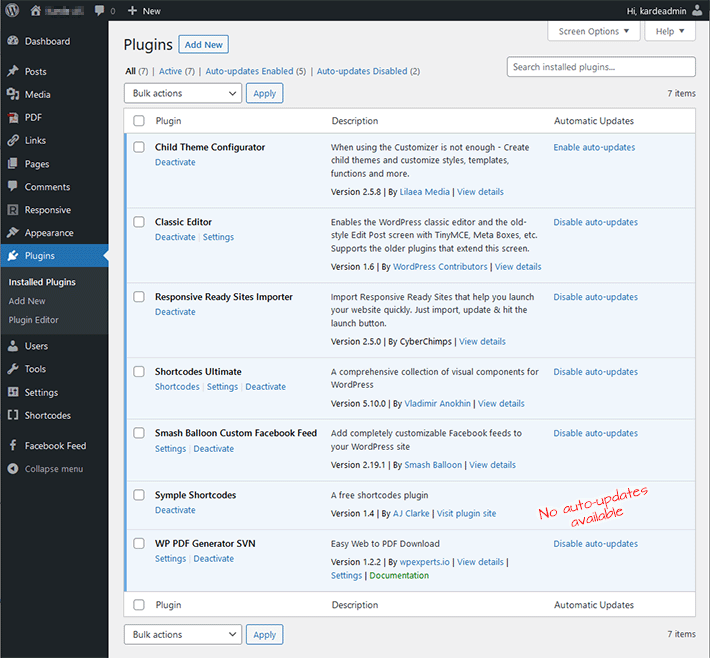Plugins
This chapter discusses some of the interfaces and tools you may use in the day to day administration of a WordPress website.
Table of contents
- Introduction
- Installing plugins
- List plugins
- Update plugin
- Deactivate and uninstalling plugins
- Final word
WordPress plugins discussed in this chapter: Symple Shortcodes.
Introduction
Extensions to WordPress are called plugins.
Plugins are located in or below the wp-content directory.
Regular plugins are located in a subdirectory named plugins.
Must Use Plugins are located in a subdirectory named mu-plugins.
Drop-in Plugins are located in the wp-content directory.
Installing plugins
Plugins hosted on https://wordpress.org/plugins/ can be installed from the the GUI or the CLI.
Example: Using the CKI to install the latest version from of Search & Replace from wordpress.org and activate:
$ wp plugin install search-and-replace --activate Installing Search & Replace (3.2.1) Downloading installation package from https://downloads.wordpress.org/plugin/search-r… Unpacking the package... Installing the plugin... Plugin installed successfully. Activating 'search-and-replace'... Plugin 'search-and-replace' activated. Success: Installed 1 of 1 plugins.
Source WP: wp plugin install.
Plugins hosted elsewhere need to be installed by some other means – often by downloading and unpacking a zip-file in the plugin directory. One example of such a plugin is Symple Shortcodes.

List plugins
$ wp plugin list +--------------------------+--------+-----------+---------+ | name | status | update | version | +--------------------------+--------+-----------+---------+ | classic-editor | active | none | 1.6.2 | | equal-height-columns | active | available | 1.1.3 | | genesis-columns-advanced | active | none | 2.0.3 | | soliloquy-lite | active | none | 2.6.2 | | shortcodes-ultimate | active | none | 5.11.1 | +--------------------------+--------+-----------+---------+
It can be filtered on field name. For instance to list only the plugins that have an update available:
$ wp plugin list --update="available" +--------------------------+--------+-----------+---------+ | name | status | update | version | +--------------------------+--------+-----------+---------+ | equal-height-columns | active | available | 1.1.3 | +--------------------------+--------+-----------+---------+
Source WP: wp plugin list.
Update plugin
To update a single plugin:
$ wp plugin update custom-facebook-feed Downloading update from https://downloads.wordpress.org/theme/custom-facebook-feed.4.0.zip... Unpacking the update... Installing the latest version... Removing the old version of the plugin... Plugin updated successfully. Success: Updated 1 of 1 plugins. +----------------------+-------------+-------------+---------+ | name | old_version | new_version | status | +----------------------+-------------+-------------+---------+ | custom-facebook-feed | 2.2 | 4.0 | Updated | +----------------------+-------------+-------------+---------+
To update all plugins:
$ wp plugin update --all
Deactivate and uninstalling plugins
To uninstall a plugin, first deactivate it from the GUI or CLI, then delete it:
$ wp plugin deactivate hello $ wp plugin delete hello Success: Deleted 1 of 1 plugins.
Deactivating makes it no øonger active, deleting removes it from the file system.
Sources: deactivate, delete, Proper, Dummies.
Must Use Plugins cannot be disabled as long as they are in the mu-plugins subdirectory. To disable, first move to the plugins directory,
then disable it.
 Wordpress.SE: How to disable mu-plugins?
WPengine: Removing Unused WordPress Plugins.
Wordpress.SE: How to disable mu-plugins?
WPengine: Removing Unused WordPress Plugins.
Final word
[TBA]
Last update: 2021-12-05 [gh].